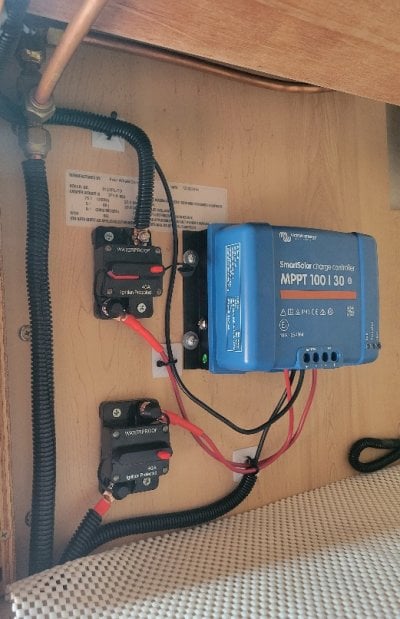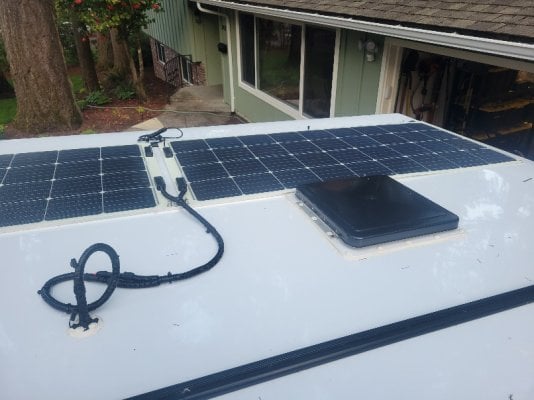Hey everyone! Just finished my solar install and wanted to ask a few questions and I guess double check my system against the experts. I have a 2014 fwc fleet. Looking to make sure everything here is appropriate and won't be a fire hazard etc with the pre-installed 12g wiring.
I added 350w of renogy flexible solar panels wired in series to the roof for lithium and the smaller wiring. I have a 206ah sok lithium battery I charge to 14.4v and a 100/30 victron mppt solar charge controller.
The panels come into the 12g sae roof connection mounted with 10g mc4 connectors and a sae adaptor for the reversed polarity issue fwc has. It then runs on the stock 12g wiring to the charge controller and 10g wiring from the storage cabinet through a predrilled hole into the battery. The 10g is roughly just a couple of feet. I spliced the wiring found from the pump cabinet area and just left the old wiring "dead" that runs into the battery compartment. Nothing fit there for the install so had to come up with something else.
I added a 40amp breaker (let me know if you guys think 30 amps is better here) and then another before the battery (again at 40 amps).
I have found a few forums on here regarding the amp rating and length of wire for the pre-installed 12g wiring. Does my system seem ok here? I don't want a fire hazard etc.
Here are some panel specs:
Maximum Power at STC: 175W
Module Efficiency: 17.3%
Optimum Operating Voltage (Vmp): 19.5V Open-Circuit Voltage (Voc): 23.9V
Optimum Operating Current (Imp): 8.89A Short-Circuit Current (Isc): 9.50 A
Operating Temperature: -40°F to 185°F (-40ºC to +85ºC)
Maximum Series Fuse Rating: 15A
I added 350w of renogy flexible solar panels wired in series to the roof for lithium and the smaller wiring. I have a 206ah sok lithium battery I charge to 14.4v and a 100/30 victron mppt solar charge controller.
The panels come into the 12g sae roof connection mounted with 10g mc4 connectors and a sae adaptor for the reversed polarity issue fwc has. It then runs on the stock 12g wiring to the charge controller and 10g wiring from the storage cabinet through a predrilled hole into the battery. The 10g is roughly just a couple of feet. I spliced the wiring found from the pump cabinet area and just left the old wiring "dead" that runs into the battery compartment. Nothing fit there for the install so had to come up with something else.
I added a 40amp breaker (let me know if you guys think 30 amps is better here) and then another before the battery (again at 40 amps).
I have found a few forums on here regarding the amp rating and length of wire for the pre-installed 12g wiring. Does my system seem ok here? I don't want a fire hazard etc.
Here are some panel specs:
Maximum Power at STC: 175W
Module Efficiency: 17.3%
Optimum Operating Voltage (Vmp): 19.5V Open-Circuit Voltage (Voc): 23.9V
Optimum Operating Current (Imp): 8.89A Short-Circuit Current (Isc): 9.50 A
Operating Temperature: -40°F to 185°F (-40ºC to +85ºC)
Maximum Series Fuse Rating: 15A


